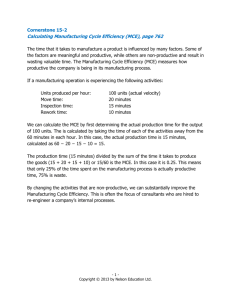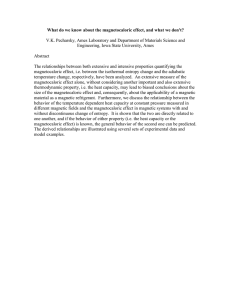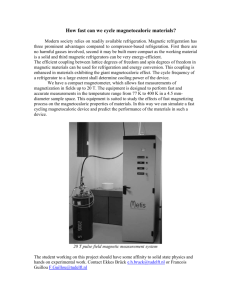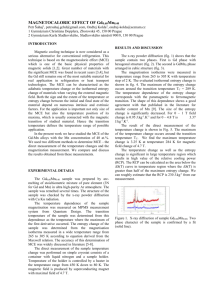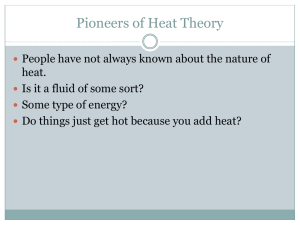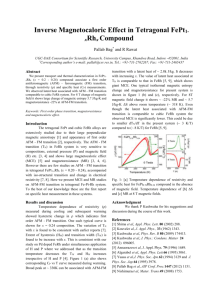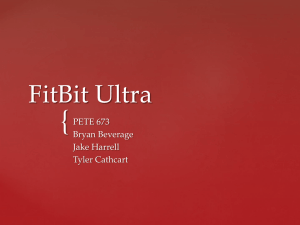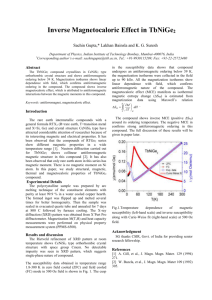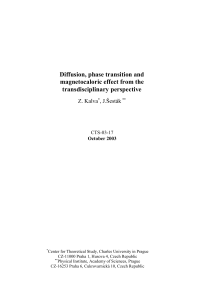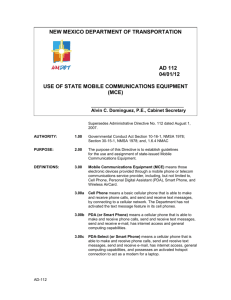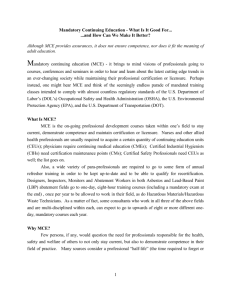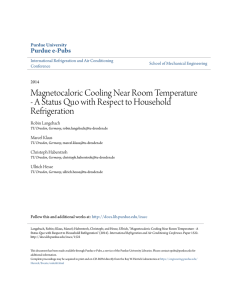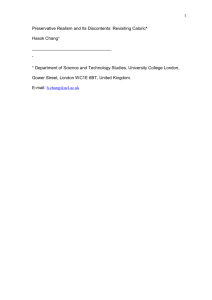УДК 621.564.27=111 CALORIC EFFECTS IN FERROICS Gudkov
advertisement
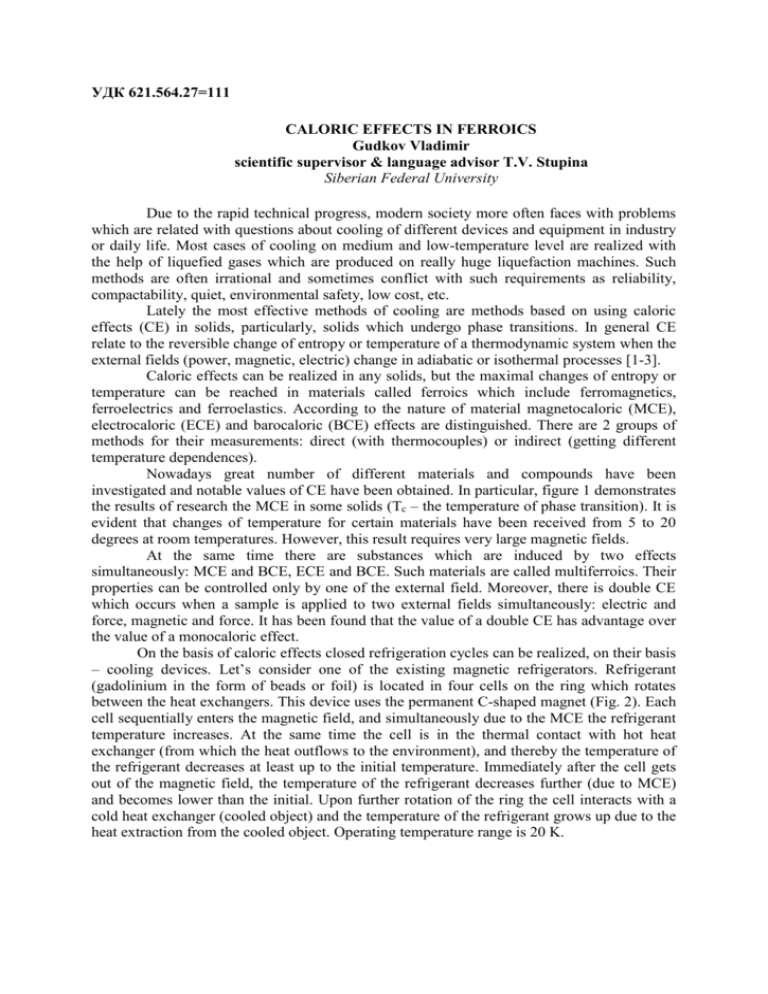
УДК 621.564.27=111 CALORIC EFFECTS IN FERROICS Gudkov Vladimir scientific supervisor & language advisor T.V. Stupina Siberian Federal University Due to the rapid technical progress, modern society more often faces with problems which are related with questions about cooling of different devices and equipment in industry or daily life. Most cases of cooling on medium and low-temperature level are realized with the help of liquefied gases which are produced on really huge liquefaction machines. Such methods are often irrational and sometimes conflict with such requirements as reliability, compactability, quiet, environmental safety, low cost, etc. Lately the most effective methods of cooling are methods based on using caloric effects (CE) in solids, particularly, solids which undergo phase transitions. In general CE relate to the reversible change of entropy or temperature of a thermodynamic system when the external fields (power, magnetic, electric) change in adiabatic or isothermal processes [1-3]. Caloric effects can be realized in any solids, but the maximal changes of entropy or temperature can be reached in materials called ferroics which include ferromagnetics, ferroelectrics and ferroelastics. According to the nature of material magnetocaloric (MCE), electrocaloric (ECE) and barocaloric (BCE) effects are distinguished. There are 2 groups of methods for their measurements: direct (with thermocouples) or indirect (getting different temperature dependences). Nowadays great number of different materials and compounds have been investigated and notable values of CE have been obtained. In particular, figure 1 demonstrates the results of research the MCE in some solids (Tc – the temperature of phase transition). It is evident that changes of temperature for certain materials have been received from 5 to 20 degrees at room temperatures. However, this result requires very large magnetic fields. At the same time there are substances which are induced by two effects simultaneously: MCE and BCE, ECE and BCE. Such materials are called multiferroics. Their properties can be controlled only by one of the external field. Moreover, there is double CE which occurs when a sample is applied to two external fields simultaneously: electric and force, magnetic and force. It has been found that the value of a double CE has advantage over the value of a monocaloric effect. On the basis of caloric effects closed refrigeration cycles can be realized, on their basis – cooling devices. Let’s consider one of the existing magnetic refrigerators. Refrigerant (gadolinium in the form of beads or foil) is located in four cells on the ring which rotates between the heat exchangers. This device uses the permanent C-shaped magnet (Fig. 2). Each cell sequentially enters the magnetic field, and simultaneously due to the MCE the refrigerant temperature increases. At the same time the cell is in the thermal contact with hot heat exchanger (from which the heat outflows to the environment), and thereby the temperature of the refrigerant decreases at least up to the initial temperature. Immediately after the cell gets out of the magnetic field, the temperature of the refrigerant decreases further (due to MCE) and becomes lower than the initial. Upon further rotation of the ring the cell interacts with a cold heat exchanger (cooled object) and the temperature of the refrigerant grows up due to the heat extraction from the cooled object. Operating temperature range is 20 K. Fig. 1. Dependence of MCE in adiabatic conditions as functions of magnetic field [4]. The main advantage of refrigeration devices based on the use of caloric effects is a big density of a solid in comparison with a density of steam or gas. That’s why the use of dielectric or magnetic material as a working medium provides the possibility of creating significantly more compact fridges. Besides, solid coolers have the important features: 1) convenience and ease of operation that allow to create unattended equipment in space, sea and hard to reach areas of land; 2) noiseless work; 3) spatial orientation independence; 4) ability to use an integral version, for example, when a cooler and electronic functional scheme are produced in one technological cycle. Fig. 2. Magnetic refrigerator with a stationary magnet [5]. Significant disadvantages of solid-state refrigerants are: 1) impossibility of a good thermal contact with the cooled object; 2) impossibility to use MCE without large magnets (which must be shielded), especially in the field of room temperature. ECE and BCE need high electric voltage and pressure, which require additional means of safety; 3) relatively high price of solid-state materials with a significant caloric effect. In conclusion, we can say that the investigation of CE of different physical nature is a very perspective direction, contributing to the development of fundamentals of CE and their practical use by creating solid-state coolers. That’s why lately there is the intensification of research of CE, and further progress largely depends on the success in the field of materials. But now materials with significant values of monocaloric effects have been already obtained, and it allows us to consider them truly effective for application as solid-state refrigerants. REFERENCES 1. 2. 3. 4. 5. Flerov I.N. Caloric effects in solids and perspectives of their practical use // Izvestiya StPSURFT – 2008. – № 1. – p. 41-63. Tishin A.M., Spichkin Y.I. The Magnetocaloric Effect and its Applications. – Bristol and Philadelphia: Institute of Physics Publishing. – 2003. – 475 р. Sinyavski Y.V. Electrocaloric refrigerators - promising alternative to modern lowtemperature devices. Chemical and petroleum engineering. – 1995. – № 6. – p. 5-12. Gschneidner K.A. Jr., Pecharsky V.K., Tsokol A.O. Recent developments in magnetocaloric materials // Rep. Prog. Phys. – 2005. – V. 68. – P. 1479-1539. Gschneidner K.A. Jr., Pecharsky V.K., Tsokol A.O.// Rep. Prog. Phys., 68, 1479, 2005.
